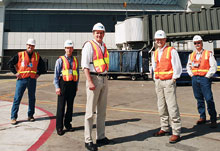 |
| LONE STARS DFW Airport team managed construction through post-9/11 design changes. Chairman Jeff Fagan (center) and executive VP Clay Paslay (second from right) led team that includes Perfecto Solis (far left), Jim Crites (second from left) and Andrew Bell (right). |
R. Clay Paslay, DFW executive vice president, sees the program as a multilayered puzzle whose last piece is falling into placethe finalization of the terminals $627-million guaranteed maximum price bid with prime contractor and CM at-risk Austin Commercial, Dallas. Project officials credit GMP with saving two years of possible delays from post-9/11 design changes, as the terminal now moves toward a mid-2005 opening. Flexibility in program delivery also kept work moving despite the design changes after attacks. Soft costs were no more than 18% on either terminal or transit system, officials add.
Airport officials began the project by buying a $1-billion risk insurance policy and making a 40-hour safety training plan a mandatory part of bid documents. We modified training as work progressed, says Terry Cassidy, DFW assistant vice president. Training is bilingual, with construction terms taught in Spanish and English. DFW also offers rewards for good safety records.
 |
| CLOSE ENCOUNTERS Work kept on while airport functioned. |
So far 16 million man-hours have been recorded with a 0.4 lost-time injury average, compared to a 3.9 national average. Id not heard of such high-level safety [efforts], says J. W. Garrett, safety manager for Hensel-Phelps Construction Co., Greeley, Colo., the CM at-risk and general contractor for the Skylink system. DFW asked HP and Austin Commercial to jointly create a program they could both live with, says Cassidy. Theyre the ones who know what is needed to run a safe job.
Fifteen cents of each worker-hour on the open-shop capital program are donated to a construction craft training development program in conjunction with local colleges. Some 2,500 workers have undergone training, says Cassidy.
| RELATED LINKS |
 Air Traffic Is Reviving and Construction Is Back To Basics Air Traffic Is Reviving and Construction Is Back To Basics
|
 After Setbacks, Airport Traffic and Work Is Moving Over Miami After Setbacks, Airport Traffic and Work Is Moving Over Miami
|
That will help them find future jobs as Skylink nears completion. The project consists of a $200-million guideway, $200 million in station construction, a $45-million jetway and $40 million in renovations to existing stations that serve the current American Airlines people mover, which Skylink will replace. We built a bridge structure over five miles...at the worlds third-busiest airport, says Perfecto Solis, DFW assistant vice president of project development. So important was daily coordination with airlines, subcontractors and other parties that a 40,000-sq-ft building was erected just to facilitate meetings, he says.
DFWs great amount of available greenfield space enhanced logistics. There is enough room on site to separate construction traffic, build batch plants, recycle...
(Photos courtesy of DFW)
|

Post a comment to this article
Report Abusive Comment